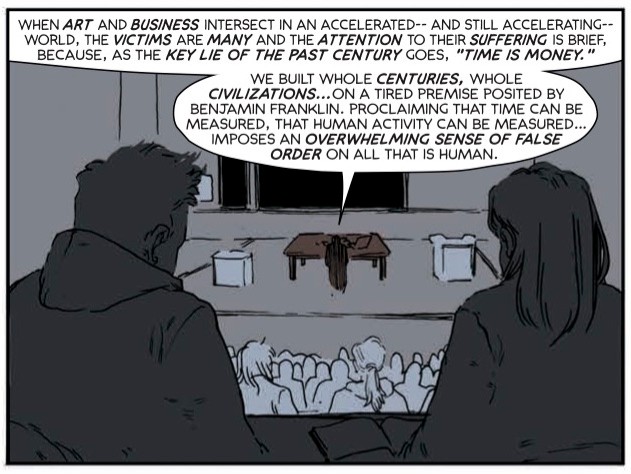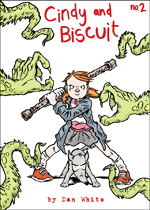Material #1-4: Breaking Free
October 28th, 2015
A few thoughts on Material, a prematurely cancelled comic by Will Tempest, Tom Muller, Ales Kot and Clayton Cowles that feels like it’s worth not just reading but talking about – and maybe even continuing?
!) IT’S ABOUT TIME
Like so much contemporary mass media, Material seemed aware of its readers’ ability to act as biocapitalist broadcasting stations, trusting that they would work harder and smarter than Image comics’ marketing department – that its readers would talk about it on podcasts, write essays, send enthusiastic tweets, anything to try and share the experience of it. Its methods of going about this was somewhat obvious but effective: the comic lectured you, provided prompts for further reading, tried to link scenes in the comic to other texts, be they topical text pieces in the back of the comic or the names and references scattered in the margins.
Even while it was still being published, then, Material seemed to revel in its status as an incomplete text. The art echoed this approach, with with Will Tempest’s none-more-loose linework held together almost entirely by the carefully coded block colouring. It looked and felt like work-in-progress, and with the action currently suspended, its characters’ lives have that feeling too.
Everything in this book is material for the reader; the question is, how much work do you want to put in? How much do you want to let Material work with you?
As I’ve already said, by publicly engaging with the comic we become part of the marketing scheme, “self-facilitating media nodes” or some such Barley-bollocks. Is that all there is to it though? Value is fundamental to the idea of currency of course, and when you’re offering up cash on the promise of receiving a worthwhile experience it’s doubly hard to disentangle financial motives from your response, but that doesn’t mean that we should give in to the tautological worldview that says since everything can be sold it is best judged by its commercial worth.
Material‘s current status gives us pause to consider this question, temporarily free from questions of cash money and how to spend it. It brings the other questions of trust – is this going anywhere? is it just wearing the raw tragedy of the moment like a shiny new suit? – into the foreground.
All you need to spend right now are the last few free minutes of your day. All Material is currently asking you to spend is your life.
(anyone else worried they’re going to dress as Paul Mason for Halloween?)
“) CONNECTED/CONNECTIONS
There was a certain point in The Wire where I realised that the end-of-season montages were the motivation for the device, marking as they did the exact point at which the show’s creeping, pernicious modern mythology seemed inescapable rather than merely convincing.
These climactic flourishes managed the impossible, showing the web of connections the show built up without turning it into a capitalist-realist training montage for mankind – after so many hours of television, you had built up the knowledge required to find the mere site of a man putting on a hat both crushing and hilarious.
This trick is replicated in the best examples of the traditional social novel, in George Eliot and elsewhere. It’s an approach that Material maintained an uncertain relationship with as a “live” comic – four issues in, after so many repetitions of and deviations from that nine-panel grid, it still wasn’t clear whether or not the book’s individual story threads would come together or if their mere juxtaposition was supposed to provide connection enough – and the comic now exists in a sort of quantum superposition, as both a work that’s building towards such a climax and one that’s going to avoid it forever.
If I can risk honesty for a second, this is pretty close to my ideal version of what Material is or could be. The first four issue can be read and reread on a loop that never quite comes together, free for now from Magnolia sign-songs or big conclusions – though perhaps in making that comparison should pause to consider whether or not Magnolia takes place in “a latter-day Tower of Babel, in which everyone speaks the same language but no one communicates”. The characters in Material – movie people, victims of government torture, brutalised black kids, professors – do not necessarily share a common language despite being presented in one.
These connections would be valuable. I wish that I could say that this book had successfully made them.
I could still wax rhapsodic about Material being a version of one of those end-of-series Wire montages, of course. I could argue that the difference here is that you’re expected to provide the links, the translation, that the book was all about people living separate lives, framed by alien references with only the reader to unite them. I could do that – and having started down that road, I can be pretty sure that I would enjoy it – but the doubt would still linger, that sense that maybe I privileged the unresolved version because it means that those bonds of trust between reader and creative team don’t have to be truly put to the test…
£) IN THE END, EVERYBODY WINS
Thinking about some of the criticisms of Material that have popped up in our comments section already – and trust me, I love nothing more about Material than the fact that it gives you something to actually rail against, that its subjects matter – it occurs to me that this sense of trust, whether it was/is justified, has been at the heart of them.
Here’s what might be the harshest Material-related comment we’ve received, an anonymous dart aimed straight at the heart of the project:
Material, judging by this premiere issue, is the opposite of where modern comics should go. We should be addressing the root causes of these problems instead of aestheticizing their mystique.
It’s a comic for those who prefer philosophy to political organizing. Kot wasn’t there at those demonstrations. He doesn’t know what we go through (as a white participant I honestly can’t say I do either, there’s that immunity to harsh sentencing my paleness brings.) Motherfucker just watches this shit on the news and says “wow, what a cool and trendy inspiration for my content!” It would be infuriating if it wasn’t such a niche product for a niche audience. But that in itself is the problem. Such a comic couldn’t be built to influence people, by the very nature of its publishing. We gotta oughta probably do better than this. I look forward to whoever does it first.
As I said, what we have here is an absence of trust in the creators of the comic, an understandable worry that real trauma is being processed, made exciting, maybe even palatable, for the pleasure of a tiny audience.
And size does matter here, too. After all, if it’s only us in here speaking to each other we can afford to be good, right? Or at the very least, we can afford to be better.
In defence of Material as it currently exists, it’s a book that always tries to humanise the victims of our current moment rather than its perpetrators, than those who profit from it through brute action or blunt complicity. Compare it to that Run the Jewels/A.G. Rojas video embedded above. The video’s aims are noble but the results are mixed: in straining to the flesh and blood humans on both sides of America’s institutional violence, it elides the power imbalance involved, the vast apparatus that favours white over black, cop over citizen.

Material has managed to avoid this trap thus far. Four issues in and its characters, for all their differences, are still trying to find a way to meaningfully define themselves against the contexts they’ve had forced upon them. There are layers to this scheme, of course. All of our protagonists have an active relationship with an authority figure, be it a dominatrix, a movie director, an anonymous voice on the internet or a cop, but these layers always point the reader outwards, towards the greater structures above them, to traumas and powers of coercion and commerce that remain inhumane and overbearing.

$) FLESH WITHOUT BLOOD
Finally, we arrive at a point that might bring Material‘s hopeful readers with its sceptical ones together: the awareness, however you want to spin it, that what’s here can never be enough.
Some of us might spin that as a sign of generosity, while some will find in it a confirmation of cowardice, but who can truly say that they’ve had their position validated? That they have banished all doubts that their feelings were the right ones? That they have correctly weighed the book’s value as a point of contact between living people in 2015?
This will sound harsh but I say it with love: there is no contemporary comic that I would be happier to move beyond than Material. This is the direction that its techniques are pushing in, the next step that its politics demand, the only plausible way to reconcile its own awareness of how consumer culture works with its status as product: to move far, far away from the comic itself.
The suspension of Material – and therefore of the sense of trust that has been invested or withheld by the reader – might seem to facilitate this process but the opposite is true. Our sense of other people’s intentions, of their plans, their desires, is by necessity incomplete but we do our best to make sense of the clashes between their stories and ours despite all of that. Some relationships are harder to fathom than others, particularly when they are broken off before anyone involved seemed ready to end them. Time has been returned to us, but this is not a simple kindness – we control how much of it we spend, but the absence of a conclusion leads to the temptation of rampant speculation.
As it stands, Material leaves me feeling like one of its sketchily drawn background characters. Contra Gary Lactus, I enjoyed this aspect of the book’s aesthetic, thought it was politically resonant and gave the book its rough energy, drawing our attention to how little of that particular resource we have to spread around while also adding to the sense that this was a comic that needed to be finished, and quickly. This is the one element of the comic that I have clear and unambiguous feelings about in this moment.
Right now I don’t know whether I was a partner or a self-replicating product, but I know that I would be willing to pay good money to find out.









Leave a Reply
You must be logged in to post a comment.